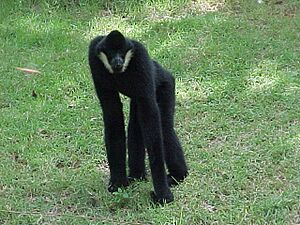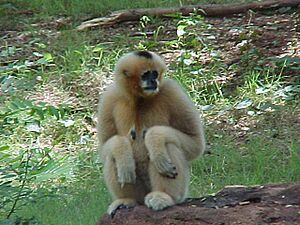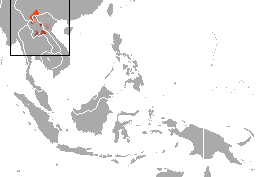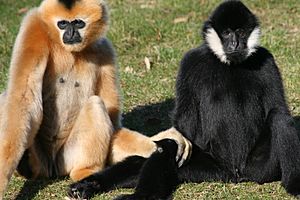Northern white-cheeked gibbon facts for kids
Quick facts for kids Northern white-cheeked gibbon |
|
|---|---|
 |
|
| Adult male | |
 |
|
| Adult female | |
| Conservation status | |
| Scientific classification | |
| Genus: |
Nomascus
|
| Species: |
leucogenys
|
 |
|
| Northern white-cheeked gibbon range (brown — extant, orange — probably extinct) |
|
| Synonyms | |
|
Hylobates leucogenys (Ogilby, 1840) |
|
The northern white-cheeked gibbon (Nomascus leucogenys) is a type of gibbon that lives in Southeast Asia. It is currently listed as Critically Endangered, meaning it's at a very high risk of disappearing forever.
This gibbon is closely related to the southern white-cheeked gibbon (Nomascus siki). For a long time, scientists thought they were the same species. The females of both species look almost identical.
Scientists studied the complete genetic code (genome) of the northern white-cheeked gibbon. They published their findings in 2011.
Contents
About Northern White-Cheeked Gibbons

Northern white-cheeked gibbons show sexual dimorphism. This means males and females look different. Males are black all over their bodies. They have clear white patches on their cheeks. Males also have a tuft of hair on top of their heads and a special throat pouch called a gular sac.
Females are a reddish-tan color. They do not have the head tuft. Instead, they have a crest of black or dark brown fur running from their head down to their neck. These gibbons usually weigh about 7.5 kilograms (about 16.5 pounds). However, this number comes from only a few wild gibbons. Those living in zoos seem to be heavier.
Like other gibbons, both males and females have very long arms. Their arms are 1.2 to 1.4 times longer than their legs. They also have strong thighs and shoulders. This suggests they are very strong. When swinging through trees, adult gibbons often prefer using one hand more than the other. They can be either right-handed or left-handed.
This species looks a lot like the southern white-cheeked gibbon. However, the northern gibbon has slightly longer body hair. Their calls also sound a little different. You can tell the males apart by the shape of their white cheek patches. In the northern species, these patches reach the top of their ears. They do not touch the corners of the mouth. In the southern species, the patches only go halfway to the ears and surround the lips completely.
Where They Live and What They Eat
Today, northern white-cheeked gibbons are found only in northern Vietnam and northern Laos. They used to live in southern China, in Yunnan province. However, they were confirmed to be extinct in China by 2013.
In Laos, about 57 groups of gibbons were counted in the Nam Et-Phou Louey National Protected Area in 2019.
In Vietnam, at least 22 groups of these gibbons were found in Pù Mát National Park. This park is in Nghệ An Province, near the border with Laos. Another large group of 64 gibbon families, totaling 182 individuals, was found in the Xuan Lien nature reserve in Thanh Hoa province in 2020. This was a big increase from 2011, when only 41 groups were recorded there.
Scientists do not currently recognize any different types (subspecies) of the northern white-cheeked gibbon. However, the southern white-cheeked gibbon was once thought to be a subspecies of this one. These gibbons live in thick, green subtropical forests. They prefer areas between 200 and 1650 meters (about 650 to 5400 feet) above sea level.
Northern white-cheeked gibbons spend most of their time in trees. They mainly eat plants, especially fruits. They also eat some leaves, buds, and flowers. About 10% of their diet can be insects and other small animals.
They are generally friendly and live in groups of up to six gibbons. Each group usually stays in its own area and defends it from other groups. They are diurnal, meaning they are active during the day. At night, they sleep in high tree branches, often hugging each other tightly. Studies have shown that these gibbons can recognize themselves in mirrors, which is a sign of intelligence.
Communication and Calls
The calls of northern white-cheeked gibbons are very complex. The sounds made by males and females are quite different. The most special calls are the duets sung by a male and a female together.
These duets start with the female making 15 to 30 notes. The pitch of her notes gets higher and higher. Then, the male joins in with a complex call that changes quickly. This whole cycle lasts less than 20 seconds. The pair then repeats the cycle, getting louder and more intense, for five to 17 minutes.
In the related southern species, these duets are most common at sunrise, especially on sunny days. Studies in zoos show that males and females who sing duets together most often are more likely to become mates. This suggests that singing together helps them form strong bonds.
Sometimes, males or females will sing these calls alone. Young gibbons might also join in, creating a full "chorus." Besides the duets and solo calls, males can also make booming sounds using their throat pouches. They can also make short, single notes.
Reproduction and Life Cycle
Northern white-cheeked gibbons are monogamous. This means they form long-lasting pairs. The female's reproductive cycle lasts about 22 days. Pregnancy lasts between 200 and 212 days.
When they are born, both male and female gibbons have yellow-buff fur. They weigh about 480 grams (just over 1 pound). Around one year of age, their fur changes to black. They also develop pale patches on their cheeks. Their adult fur, which shows the male and female differences, grows in when they are about four or five years old. During their younger years, they sing calls that sound like the female's calls. They also spend a lot of time playing.
Northern white-cheeked gibbons become old enough to have babies at seven or eight years of age. They have been known to live for at least 28 years in the wild.
Images for kids




